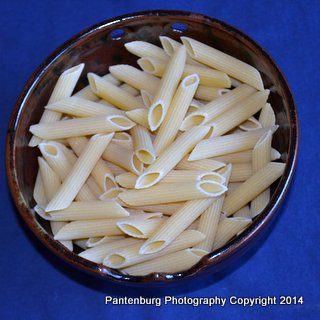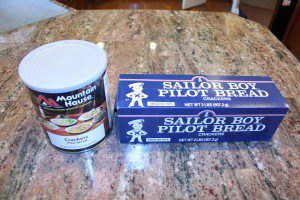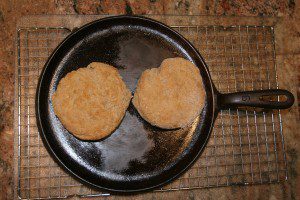Survival Food Recipes and Off-Grid Cooking
One element of survival is nutrition. There are instances when food is fuel, and the only concern is ingesting more calories than you burn up. (That even sounds unappetizing!) But there are ways to prepare basic, staple TASTY foods using off-the-grid methods: i.e. over a campfire, in a Dutch oven or by using aluminum foil wraps. Learn how to cook over a single heat source, using simple, tried-and-tested cooking methods!
Monday, January 12, 2015
Wednesday, December 17, 2014
Thursday, December 11, 2014
Saturday, December 6, 2014
Saturday, March 22, 2014
Make Pasta Alfredo sauce from storage foods
Pasta is easy to store and simple to cook - all you do is boil it in water. In an emergency situation, this can be done over a campfire, biomass stove, or just about anything that can produce heat.
But how will you make it taste good?
The answer is a sauce of some sort that brings variety to the menu, and keeps every pasta meal from tasting the same. This recipe uses simple ingredients that every well-stocked pantry should have.
 Storage pasta can become a delicious meal when combined with this Alfredo sauce recipe.
Storage pasta can become a delicious meal when combined with this Alfredo sauce recipe.
Alfredo sauce from storage foods
3-1/2 c water
1-1/2 tsp Italian seasoning mix
1 c white cream soup base
1/4 tsp chicken soup base
1/4 tsp garlic granules
1/4 tsp pepper, ground black
1/2 c Parmesan cheese, grated, dehydrated
In a medium saucepan, bring water to a boil, add white cream soup base, lower to a low heat, whisking cream soup base until smooth.
Add all other ingredients, continue whisking, lower heat to simmer, whisk or stir occasionally, cook until sauce is desired thickness. Serve over pasta.
- From Jan's Fabulous Food Storage Recipes: Converting Stored Foods into Useable Meals by Jan LeBaron
Please click here to check out and subscribe to the SurvivalCommonSense.com YouTube channel, and here to subscribe to our weekly email update - thanks!
But how will you make it taste good?
The answer is a sauce of some sort that brings variety to the menu, and keeps every pasta meal from tasting the same. This recipe uses simple ingredients that every well-stocked pantry should have.
 Storage pasta can become a delicious meal when combined with this Alfredo sauce recipe.
Storage pasta can become a delicious meal when combined with this Alfredo sauce recipe.Alfredo sauce from storage foods
3-1/2 c water
1-1/2 tsp Italian seasoning mix
1 c white cream soup base
1/4 tsp chicken soup base
1/4 tsp garlic granules
1/4 tsp pepper, ground black
1/2 c Parmesan cheese, grated, dehydrated
In a medium saucepan, bring water to a boil, add white cream soup base, lower to a low heat, whisking cream soup base until smooth.
Add all other ingredients, continue whisking, lower heat to simmer, whisk or stir occasionally, cook until sauce is desired thickness. Serve over pasta.
- From Jan's Fabulous Food Storage Recipes: Converting Stored Foods into Useable Meals by Jan LeBaron
Please click here to check out and subscribe to the SurvivalCommonSense.com YouTube channel, and here to subscribe to our weekly email update - thanks!
Saturday, March 15, 2014
Make waterfowl gumbo with this simple recipe
Gumbo is on the menu for about 50 Boy Scouts and volunteers today (Jan.4, 2014) as part of the annual Christmas tree recycling fundraiser. It's 19 degrees outside, and several of us volunteers will be doing all the cooking outdoors. Here's another addition to your survival kit: a recipe for duck or goose gumbo.
by Leon Pantenburg
A successful waterfowl hunter may end the season with a bunch of ducks and geese in the freezer. So how do you cook them so everyone can enjoy them?
My favorite waterfowl dish is gumbo. There are dishes, such as this one, that just don't taste as good unless you use a gamebird such as a pheasant, chuker, duck or goose in them! In a pinch, you can use chicken. I prefer the dark meat, and generally get a big pack of thighs.
If you do the initial cooking at home, you can de-bone and pack the meat in a plastic bag. Then, at hunting camp, you can add the rest of the ingredients to make a quick meal.
The beauty of this recipe is that it can all be done in one large Dutch oven or pan, as long as you have a heat source. The simplicity and ease of cooking makes duck gumbo a valuable wilderness survival recipe, while the flavor makes it a gourmet meal! If you bake some biscuits or sourdough bread in a Dutch oven to go along with this, you'll get major kudos.
I've been doing variations of this basic recipe for years, and you can mix any number of game birds to create a delicious gumbo. This is a favorite with the Troop 18 adult patrol on Boy Scout campouts!
Duck Gumbo
3 large, or 6 small ducks, or 2 geese
1 large onion, diced
1/2 Tbs black pepper
Tony Chachere's Famous Creole Seasoning (If you can find it! Other Creole seasoning may have to be substituted!
Place waterfowl in a large pot with enough water to cover. Add onions and pepper. Bring to a boil; reduce
heat and simmer two to six hours. Removed meat and let cool. Reserve stock. Bone waterfowl and chop meat coarsely. Season generously with Creole seasoning.
1 c vegetable oil, mixed with 1 c flour
2 large onions, chopped
2 ribs celery, chopped
2 bell peppers, chopped
6 cloves garlic, chopped
1 lb okra, chopped or 2 10-ounce packages of frozen chopped okra
4 crumbled bay leaves
2 Tbs Worcestershire sauce
1 tsp red pepper
1 tsp thyme
2 tsp Tabasco brand pepper sauce
salt and pepper to taste
dash of file powder
cooked rice
Make a roux by cooking flour and oil in large skillet, stirring constantly, until it is peanut butter brown. Add onions, celery, bell peppers, garlic and okra. Saute for 15 to 20 minutes. Add meat and cook another 20 minutes. Skim grease from the reserved stock and add to the mixture. (There should be enough liquid to fill the pot about 2/3 full; If not add water to bring to that level.)
Bring to a boil. Add bay leaves, Worchestershire sauce, red pepper thyme, TABASCO, salt and pepper. Reduce heat; cover and let simmer for one hour. Sprinkle with file powder and serve over rice.
Make mocha coffee mix with storage foods
I was really sad when my favorite "Double Dutch Chocolate" coffee mix was discontinued. So, always up for a challenge, I decided to try to make my own version. You should have most of these ingredients already in your pantry.
 Familiar comfort food can be a survival necessity. This coffee drink can be easily made with storage foods. (Photo: Karla Pantenburg Moore)
Familiar comfort food can be a survival necessity. This coffee drink can be easily made with storage foods. (Photo: Karla Pantenburg Moore)by Karla Pantenburg Moore
Mocha Coffee Mix
1 1/2 cups non-fat Dry Milk3/4 cup Powdered Sugar
3/4 cup Powdered Creamer
1/2 cup baking Cocoa (I used Dutch Processed)
1/3 cup Instant Coffee (reg or decaf)
1/4 tsp. salt
2 rounded TBSP. Malt Powder
Sift ingredients together. Store in an air-tight container in a cool pantry.
Mix 3 rounded tablespoons mix into a mug with boiling water. Stir well.
It tastes better when sipped out of an Artisan mug...
For more survival and off-grid cooking tips, check out and please follow: Survival Pantry
Karla Moore is a professional soaper, accomplished Dutch oven cook, prepper and avid do-it-yourselfer. She is the author of "Survival Pantry" blog, and walks the talk when it comes to preparedness. Karla, and her husband Warren, live on a small farm outside Gilbert, Iowa.
The Moores have a large garden and several fruit trees, and Karla cards, spins and dyes wool, sews, cans, preserves food and makes cheese. In season, she and Warren are avid mushroom hunters.
Karla owns and operates "Heart of Iowa" soapworks. She started making soaps for her own personal use, and started her business in April, 2000. Karla has very sensitive skin and is allergic to the detergents used in most commercial soaps. Her experimentation, and earlier training as a cosmetologist, subsequently lead to a line of soaps designed for people with allergies or similar skin conditions.
Today, Karla sells soap products all over the world and offers a complete line of scented and specialty soaps, shampoo bars, and custom blends. Karla specializes in soaps for people with allergies and teaches soapmaking, spinning and knitting classes. She enjoys visiting with both beginner and experienced soapers.
Karla's idea of a good time is hosting a large family gathering at her farm, where she and several of her siblings team up to feed a crowd of friends, neighbors and relatives, using Dutch ovens and off-grid cooking methods!
Monday, December 23, 2013
Pilot bread: Why you should consider adding it to your storage foods
Hardtack has been an emergency ration since time immemorial. Here's a look at pilot bread, a modern day version of hardtack and why you should consider including it in your survival gear.
by Leon Pantenburg
I've carried and eaten hardtack since my time in the Confederate infantry, and baking it is another history-related activity I enjoy. When I'm really going primitive, hunting with my flintlock rifle, I might pack hardtack, jerky and dehydrated corn for lunch.
 Pilot bread is a form of modern hardtack. Consider it as an addition to your storage foods.
Pilot bread is a form of modern hardtack. Consider it as an addition to your storage foods.But if you'd rather buy a similar hard cracker product for long term storage, take a look at pilot bread. I get my pilot bread from the Freeze Dry Guy, but the product is widely available. It's a good staple to have on hand - it's sorta tasty, durable, and has a long shelf life.
If I had to describe pilot bread, I'd call it a salt-less saltine, but with a tougher texture. While the bread is hard, it is easily bitten off, and the texture is much softer than the traditional recipe hardtack I make. Pilot bread also has fewer crumbs than a standard saltine. A nice feature is the durability - pilot bread with peanutbutter and/or fruit jam stands up well to travel in a daypack.
Pilot bread is a common storage food item in Hawaii, and Alaska and The Diamond Bakery "Saloon Pilot" cracker is available in many stores. Sailor Boy brand Pilot Bread is well-known in the Northwest United States and Alaska, and I got mine at the local Food 4 Less.
It is "a very inspirational food" in Alaska, according to the Sailor Boy Facebook page. Alaskans are among the last to eat hardtack as a significant part of their normal diet. Interbake Foods of Richmond, Virginia, produces much of the commercially available hardtack under the "Sailor Boy" label—98 percent of its production goes to Alaskans.
Originally imported as a food product that could handle rigorous transportation throughout Alaska, pilot bread has become a favored food even as other, less robust foods have become available. Alaskan law requires all light aircraft to carry "survival gear," including food.
The blue-and-white Sailor Boy Pilot Bread boxes are common at Alaskan airstrips, in cabins, and virtually every village. Whether it's topped with salmon spread, seal oil or old-school Crisco and sugar, chances are if you've ever lived in rural Alaska you're familiar with that long, rectangular, navy blue box. The Alaska Dispatch claims pilot bread is soul food for rural Alaskans -mothers give it to their babies to teeth on, village grocery stores, no matter how sparse, carry it on their shelves, and seldom does a hunting party venture out in the country, or a family head to fish camp, without a supply stowed away in someone's bag.
Lots of people have their favorite ways to enjoy them: topped with cheese or Spam or spread with peanut butter and jam or honey. You can also spread them with ground meat, cheese and tomato sauce and make pizzas. some people even know how to make "pizzas" with them.
For more info from the Alaska Dispatch click on pilot bread
While I use pilot bread frequently, I also bake hardtack for backcountry trips and the bread's conversational value around the campfire. Here is a very traditional hardtack recipe from the Civil War. When done, this hardtack has the consistency of a fired brick, and lives up to the nickname of "teeth dullers."
Army Hardtack Recipe
- 4 cups flour (preferably whole wheat)
- 4 teaspoons salt
- Water (about 2 cups)
- Pre-heat oven to 375° F
- Makes about 10 pieces
Place the squares on an ungreased cookie sheet in the oven and bake for 30 minutes. Turn each piece over and bake for another 30 minutes. The crackers should be slightly brown on both sides.
The fresh crackers are easily broken, but as they dry, they harden and assume the traditional texture.
Please click here to check out and subscribe to the SurvivalCommonSense.com YouTube channel - thanks!
Tuesday, October 29, 2013
Some simple flour recipes can be invaluable when bad stuff happens, you have hungry people to feed, and there aren't a lot of ingredients available.
by Leon Pantenburg
 It only took the addition of some other grains to make this basic bannock survival ration into a tasty, nutritious food. (Pantenburg photo)
It only took the addition of some other grains to make this basic bannock survival ration into a tasty, nutritious food. (Pantenburg photo)Bannock is the traditional bread of Canada and the Northwest. Native people had no access to wheat flour prior to the arrival of European traders, although some flour substitutes existed, like wild turnips or corn, dried and ground to a powder.
Bannock actually originated in Scotland. Because bannock could be quickly prepared from readily-available ingredients, and because these ingredients lasted a long time without spoiling, bannock became a staple of European fur traders and subsequently, the native people also.
But the original recipe is nothing but flour and water, and traditional bannock is essentially frontier junk food.
Here's how to add a few ingredients to make flour-based survival foods more nutritious.
Start by amending the flour. Basic, white, bleached all-purpose flour has virtually all the nutrients taken out of it in processing. To each cup of white flour, add one tablespoon of soy flour, a tablespoon of dried milk and a teaspoon of wheat germ. According to "Classic Sourdoughs: A Home Baker's Handbook" by Ed Wood, such an amendment combines enzymes and creates a complete protein, similar to meat.
I've used this amendment for years, and you can't taste the difference in the baked goods. Try amending the flour in all your survival recipes that use white flour, such as hardtack, and you'll feel the difference. Here is the traditional bannock recipe:
 Bannock Recipe
Bannock Recipe1 c flour
4 tsp double-acting baking powder
2 Tbs powdered skim milk
Stir ingredients together; stir in water to make dough moist. Knead dough until smooth. Place in greased cast iron skillet or Dutch oven over the campfire or on coals and bake about five to 10 minutes until the top is brown. Then turn the bread and brown the other side.
A handy way to prepare for a backpacking or hiking trip is to mix all the dry ingredients in a Ziplock bag. Just add 1/2 cup of water and knead in the bag. Then take out the dough, finish kneading and spread it in the pan.
(Practice baking the bannock by the campfire. Put the dough in a greased skillet, and place it near the campfire, propped at about a 60-degree angle with a stick. When the side nearest the fire browns, flip the bread and brown the other side. In a pinch you could bake it on a plank!)
SurvivalCommonSense Bannock Recipe
1/8 tsp salt
1 Tbs soy flour
1 tsp buckwheat flour
1 Tbs flax meal
2 Tbs stone ground whole wheat flour
4 tsp double-acting baking powder
Pace all the above ingredients in a one cup measure and add enough unbleached bread flour to make one cup of dry ingredients in volume. Add 2 Tbs powdered skim milk, and stir until thoroughly mixed.
Add enough moisture to make a moist dough, and knead until smooth. Place in a greased cast iron skillet and bake. If you're making this inside, bake at 425 degrees for about 20 minutes.
Except for the different ingredients, you can treat the improved recipe just like the traditional. Put the improved bannock mixture in a ziplock bag to make later on the trail, and you can cook it just like the traditional recipe.
With either recipe, bannock is a quick, easy way to make use of wheat flour. Both recipes are good survival tools that could prove to be really useful in your survival kit!
Here's an easy, simple recipe for grilling chicken.
(Here's a way to add some poetry and fun to your next campout: Mix up one of the above recipes and get it started cooking over the fire. Then whip out this Robert Service poem and read aloud: While the Bannock Bakes.)
Comments? Check out our Facebook page!
Subscribe to:
Posts (Atom)